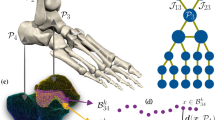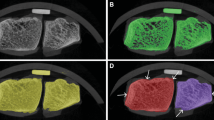Abstract
The addition of cartilage elements in a finite element model prevents bone-on-bone articulation during simulation, thus providing more accurate information about joint kinematics. We present a semi-automated method for identifying joint articulation surfaces and creating volumetric articular cartilage elements based on patient-specific bone information. The approach identifies contact surfaces based on a joint-specific, user-specified distance threshold criterion applied to a polygonized set of bones. Volumetric cartilage elements are generated using half of the minimum inter-joint distance. We present the method and then apply it to the first ray of the human foot, which includes the medial cuneiform, first metatarsal, and first proximal and distal phalanges. Distance thresholds for the first ray ranged from 3.0 to 4.25 mm depending on the joint and the desired contact surface coverage. Inter-joint distances were found and applied to the contact surfaces to generate uniformly thick cartilage models. Average inter-joint distances of 0.46, 0.72 and 0.51 mm were found for the first interphalangeal, metatarsophalangeal, and cuneometatarsal joints, respectively. The values cited are one half of the minimum inter-joint difference, as identified by the proximity algorithm. This is taken to represent the (uniform) cartilage thickness at each joint.





Similar content being viewed by others
References
Anderson DD, Goldsworthy JK, Shivanna K, Grosland NM, Pedersen DR, Thomas TP, Tochigi Y, Marsh JL, Brown TD (2006) Intra-articular contact stress distributions at the ankle throughout stance phase-patient-specific finite element analysis as a metric of degeneration propensity. Biomech Model Mechanobiol 5(2–3):82–89
Anderson DD, Goldsworthy JK, Li W, Rudert MJ, Tochigi Y, Brown TD (2007) Physical validation of a patient-specific contact finite element model of the ankle. J Biomech 40(8):1662–1669
Athanasiou KA, Liu GT, Lavery LA, Lanctot DR, Schenck RC (1998) Biomechanical topography of human articular cartilage in the first metatarsophalangeal joint. Clin Orthop Rel Res 348:269–281
Baerentzen JA, Aanaes H (2005) Signed distance computation using the angle weighted pseudonormal. IEEE Trans Visual Comput Graph 11(3):243–253
Baerentzen JA, Henrik A (2002) Generating signed distance fields from triangle meshes. IMM Technical University of Denmark, Denmark
Budhabhatti SP, Erdemir A, Petre M, Sferra J, Donley B, Cavanagh P (2007) Finite element modeling of the first ray of the foot: a tool for the design of interventions. J Biomech Eng 129(5):750–756
Camacho D, Ledoux W, Rohr E, Sangeorzan B, Ching R (2002) A three-dimensional, anatomically detailed foot model: a foundation for a finite element simulation and means of quantifying foot-bone position. J Rehabil Res Dev 39(3):401–410
Carrigan SD, Whiteside RA, Pichora DR, Small CF (2003) Development of a three-dimensional finite element model for carpal load transmission in a static neutral posture. Ann Biomed Eng 31(6):718–725
Chen WM, Lee T, Lee PVS, Lee JW, Lee SJ (2010) Effects of internal stress concentrations in plantar soft-tissue-A preliminary three-dimensional finite element analysis. Med Eng Phys 32(4):324–331
Cheung JT, Zhang M (2005) A 3-dimensional finite element model of the human foot and ankle for insole design. Arch Phys Med Rehabil 86(2):353–358
Cheung JT, Zhang M, An KN (2006) Effect of achilles tendon loading on plantar fascia tension in the standing foot. Clin Biomech 21(2):194–203
Dengler EDW (2008) A finite element model of the human foot and ankle. PhD Thesis, University of Washington, Seattle, WA
Fowler MM, Jamriska DJ (1993) Determination of the ratio of sr-82 to sr-85 by high-resolution gamma-ray counting. Abstr Pap Am Chem Soc 205:70
Garcia-Aznar JM, Bayod J, Rosas A, Larrainzar R, Garcia-Bogalo R, Doblare M, Llanos LF (2009) Load transfer mechanism for different metatarsal geometries: a finite element study. J Biomech Eng 131(2):0210111–0210117
Gebhardt A (2003) Rapid prototyping. Hanser Verlag, Munich, pp 1–34
Gilbert SL, Moore DC, Case JA, Crisco JJ (2009) Quantification of carpal cartilage facet morphology using micro-CT. In: 55th Annual meeting of the orthopaedic research society, Las Vegas, NV. Poster No. 1157
Grosland NM, Brown TD (2002) A voxel-based formulation for contact finite element analysis. Comput Methods Biomech Biomed Eng 5(1):21–32
Han SK, Federico S, Epstein M, Herzog W (2005) An articular cartilage contact model based on real surface geometry. J Biomech 38(1):179–184
Harrysson OL, Hosni YA, Nayfeh JF (2007) Custom-designed orthopedic implants evaluated using finite element analysis of patient-specific computed tomography data: femoral-component case study. BMC Musculoskelet Disord 8:91
Ledoux WR, Camacho D, Ching R, Sangeorzan B (2000) The development and validation of a computational foot and ankle model. In: Proceedings of the 22nd annual international conference of the IEE, vol 4, Engineering in Medicine and Biology Society, Chicago, IL, pp 2899–2902
Ledoux WR, Dengler EDW, Fassbind MJ (2008) A finite element foot model for simulating muscle imbalances. In: Proceedings of the 1st international foot and ankle biomechanics congress, Bologna, Italy
Marai GE, Crisco JJ, Laidlaw DH (2006) A kinematics-based method for generating cartilage maps and deformations in the multi-articulating wrist joint from CT images. Conf Proc IEEE Eng Med Biol Soc 1:2079–2082
Marchelli GLS, Ledoux WR, Ganter MA, Storti DW (2011) An automated method for creation of patient-specific volumetric articular cartilage elements in the human foot. In: The design of medical devices conference, Minneapolis, MN
McNeel (2010) Rhinoceros website. http://www.rhino3d.com/
Sarrafian SK (1993) Anatomy of the foot and Ankle: descriptive, topographic, functional. J.B. Lippincott, Philadelphia
Séquin CH (1987) Procedural spline interpolation in UNICUBIX. University of California, Computer Science Division, Berkeley
Thürmer G, Wüthrich CA (1998) Computing vertex normals from polygonal facets. J Graph Tools 3(1):43–46
Acknowledgments
This work was funded in part by the Department of Veterans Affairs Rehabilitation Research and Development Service Grant A6973R.
Author information
Authors and Affiliations
Corresponding author
Rights and permissions
About this article
Cite this article
Marchelli, G.L.S., Ledoux, W.R., Isvilanonda, V. et al. Joint-specific distance thresholds for patient-specific approximations of articular cartilage modeling in the first ray of the foot. Med Biol Eng Comput 52, 773–779 (2014). https://doi.org/10.1007/s11517-014-1179-1
Received:
Accepted:
Published:
Issue Date:
DOI: https://doi.org/10.1007/s11517-014-1179-1




